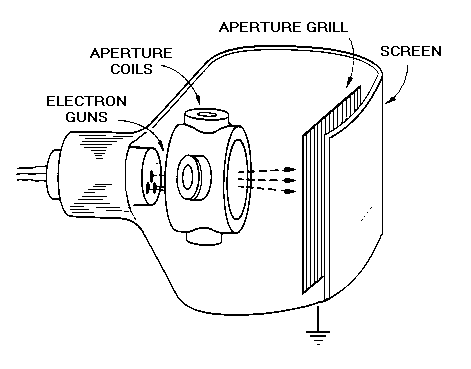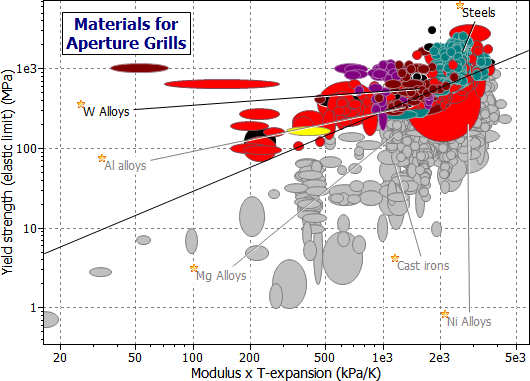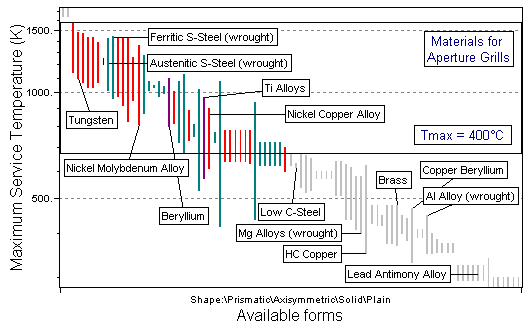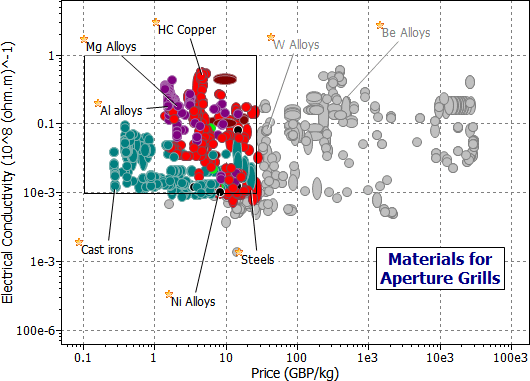
Two types of cathode ray tube (CRT) dominate the computer monitor and television marketplace. In the older technology, color separation is achieved by using a shadow mask: a thin metal plate with a grid of holes that allow only the correct beam to strike a red, green or blue phosphor. A shadow mask can heat up and distort at high brightness levels ('doming'), causing the beams to miss their targets, and giving a blotchy image. To avoid this, the newest shadow masks are made of Invar, a nickel alloy with a near-zero expansion coefficient between room temperature and 150°C. It is a consequence of shadow-mask technology that the glass screen of the CRT curves inward on all four sides, increasing the probability of reflected glare.
Sony's 'Trinitron' technology overcomes this problem and allows greater brightness, by replacing the shadow mask by an aperture grill of fine vertical wires, each about 200 mm in thickness, which allows the intended beam to strike either the red, the green or the blue phosphor to create the image (Figure 26.1). The glass face of the Trinitron tube is curved in one plane only, reducing glare.
The wires of the aperture grill are tightly stretched, so that they remain taut even when hot — it is this tension which allows the greater brightness. What is the best material from which to make them? Table 26.1 summarizes the requirements.

Figure 26.1 An aperture grill consisting of taught, vertical wires.
FUNCTION |
Precision grill for color separation in CRT |
OBJECTIVE |
Maximize electron beam intensity and thus ΔT |
CONSTRAINTS |
Thermal expansion must not relax pre-tension |
Must not creep (high maximum operating temperature) |
|
Must be electrically conducting |
|
Must be available as wire |
|
Must not cost too much |
Table 26.1 The design requirements
A thin, taut wire slackens and sags when the strain due to thermal expansion,
 |
(M26.1) |
exceeds the elastic strain caused by the pre-tension,
 . . |
(M26.2) |
Here α is the thermal expansion coefficient of the wire, ΔT the temperature rise caused by the electron beams which strike it, σ the tensile stress in the wire and E its modulus. We wish to maximize the brightness, and thus ΔT.
The tension is limited by the elastic limit of the wire, σel. Inserting this and equating the two strains (equations M26.1 and M26.2) gives
 . . |
(M26.3) |
The result could hardly be simpler. To maximize the brightness, maximize
 . . |
(M26.4) |
There is a second requirement. The wires must conduct, otherwise they would charge up, distorting the image. We therefore require, also, that
 , , |
(M26.5) |
where κ is the electrical conductivity.
Figure 26.2 is a chart of elastic limit, σel, plotted against the product Eα, The selection line for M1 is marked on it. Materials above the line have the best ability to stay taut when heated. A second stage (Figure 26.3) isolates materials which are available as wire, and have a maximum operating temperature above 400°C. The final stage (Figure 26.4) captures materials with good conductivity (the reciprocal of the electrical resistivity) and which cost less than £50/kg. The materials which pass all three stages are listed in Table 26.2.

Figure 26.2 A chart of elastic limit, σy, plotted against the product Eα, and showing the index M1.

Figure 26.3 Maximum service temperatures, Tmax, for materials which are available in the form of wire.

Figure 26.4 A 'protective' stage in which electrical conductivity, 1/ρe, is plotted against cost Cm.
MATERIAL |
σel/Eα (K) |
COMMENT |
Titanium alloys |
500 |
The best all-round performance |
Carbon Steels |
350 |
The cheapest candidate |
Stainless Steels |
350 |
Little advantage over carbon steel |
Tungsten |
400 |
Readily available as wire |
Nickel alloys |
400 |
Some available as wire |
Molybdenum alloys |
400 |
Possible, but expensive |
(Carbon Fibers) |
(1000) |
Novel choice |
Table 26.2 Materials for aperture grills
The obvious selections here are the metals, among which titanium stands out as an attractive, though expensive, choice — and metal wire is used in real aperture-grill CRTs. But if the same selection is carried out using the Metal Matrix Composites (not shown here) a new and unconventional candidate emerges: carbon fiber. Carbon fiber of about the right diameter is readily available; it conducts well, both electrically and thermally; it has high strength and — best of all — it has almost zero thermal expansion coefficient along the fiber direction.
MacUser, November, 1994, pages 96–97.